Introduction
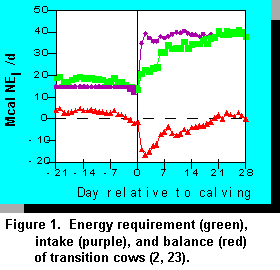 The transition period usually refers to the
final two to three weeks prior to calving. Traditionally,
this time has been used to gradually adapt cows to high grain diets that are fed during early
lactation. Without gradual adaptation to high grain diets, there is a risk of upsetting rumen
fermentation and causing the cow to go off-feed. While this is a very important aspect of
managing the transition cow, there are several other reasons why close attention must be paid to
feeding and managing the dairy cow during this period. The transition period coincides with a
time when the dairy cow is going through hormonal and metabolic changes that are orchestrated
to initiate calving and milk production. These changes cause stress to the dairy cow which may
predispose the cow to metabolic disorders that are independent of events taking place in the
rumen. The focus of this review will be on managing the dairy cow to avoid metabolic stress and
disorders that are associated with the onset of calving and milk production.
The transition period usually refers to the
final two to three weeks prior to calving. Traditionally,
this time has been used to gradually adapt cows to high grain diets that are fed during early
lactation. Without gradual adaptation to high grain diets, there is a risk of upsetting rumen
fermentation and causing the cow to go off-feed. While this is a very important aspect of
managing the transition cow, there are several other reasons why close attention must be paid to
feeding and managing the dairy cow during this period. The transition period coincides with a
time when the dairy cow is going through hormonal and metabolic changes that are orchestrated
to initiate calving and milk production. These changes cause stress to the dairy cow which may
predispose the cow to metabolic disorders that are independent of events taking place in the
rumen. The focus of this review will be on managing the dairy cow to avoid metabolic stress and
disorders that are associated with the onset of calving and milk production.Nutritional and Metabolic Status of the Transition Cow
The latest dairy NRC (23) lists only one set of nutrient requirements for the dry cow. This is probably an oversimplification. Nutrient requirements for the growing fetus increase dramatically during the last trimester of pregnancy. To make the situation worse, dairy cows tend to go off-feed during the final three weeks prepartum, particularly during the final week prior to calving. The cow is placed in a precarious position because nutrient demands are increasing at a time when feed intake is decreasing. Consequently, most cows will enter into a period of negative energy and protein balance prior to calving.
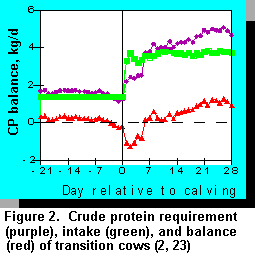 To examine the nutritional status of transition cows, we calculated (using NRC requirements) the
average energy and crude protein (CP) balances for 11 cows that were assigned to one of our
research trials (2; Figures 1 and 2).
To examine the nutritional status of transition cows, we calculated (using NRC requirements) the
average energy and crude protein (CP) balances for 11 cows that were assigned to one of our
research trials (2; Figures 1 and 2).
Cows averaged a 30% reduction in feed intake during the final 3 weeks of gestation. Forage to concentrate ratios were, 100:0, 75:25, and 50:50 for the final 4 weeks prepartum, day 1 or 2 to day 5 postpartum, and days 6 to 28 postpartum, respectively. Energy content (Mcal NEl/kg DM) and CP (%) of the diets were 1.50, 13.8; 1.61, 17.3; and 1.70, 20.8 for the three periods. Energy and protein content of the prepartum experimental diets were higher than recommended by NRC (1.26 Mcal NEl/kg, 12% CP). We repeated this exercise for the cow that experienced either the least or most severe depression in dry matter intake (DMI) between days 21 to 1 prepartum (2) and results are shown in Figure 3. Dry matter intake of cow 723 decreased from 13.1 kg to 2.19 kg/day and DMI of cow 802 from 11.8 to 10.9 kg/day during that period. This data implies that cows which avoid severe DMI depression prior to calving have a favorable nutritional balance prior to and after calving while those that go almost completely off-feed experience an extended period of negative nutrient balance during the transition period.
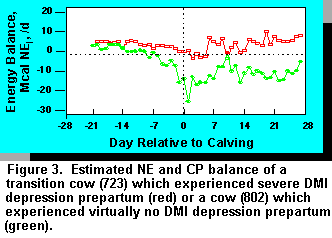
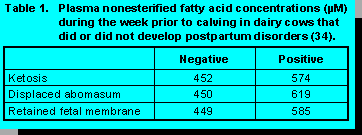 For example, plasma fatty acid, glucose, and
ketone concentrations increase dramatically
at calving and stabilize during the early postpartum period. The increase in plasma fatty acids is
due to mobilization of fat from adipose tissue and it occurs because of hormonal changes and the
cow going off-feed. During fat mobilization, fatty acids spill into blood and may ultimately be
taken up by the liver. If this is excessive, the cow can develop fatty liver. A summary of data from
five experiments (2, 29, 31, 32, 37) involving 78 cows indicated that DMI at 1 day prepartum,
expressed as a percentage of body weight, was highly correlated to liver fat (r = -.45) and plasma
fatty acids (r = -.44). Cows that eventually developed ketosis, displaced abomasum, or retained
placenta postpartum had higher plasma fatty acid concentrations immediately prepartum than
those that avoided postpartum complications (9; Table 1). The increase in plasma glucose
concentration at calving is probably due to the liver making more glucose in anticipation of
lactation, but it is also due to mobilization of glucose from glycogen stores in the liver. Work
from Iowa State University (38) indicates that fat:glycogen in the liver is positively related to the
incidence of ketosis.
For example, plasma fatty acid, glucose, and
ketone concentrations increase dramatically
at calving and stabilize during the early postpartum period. The increase in plasma fatty acids is
due to mobilization of fat from adipose tissue and it occurs because of hormonal changes and the
cow going off-feed. During fat mobilization, fatty acids spill into blood and may ultimately be
taken up by the liver. If this is excessive, the cow can develop fatty liver. A summary of data from
five experiments (2, 29, 31, 32, 37) involving 78 cows indicated that DMI at 1 day prepartum,
expressed as a percentage of body weight, was highly correlated to liver fat (r = -.45) and plasma
fatty acids (r = -.44). Cows that eventually developed ketosis, displaced abomasum, or retained
placenta postpartum had higher plasma fatty acid concentrations immediately prepartum than
those that avoided postpartum complications (9; Table 1). The increase in plasma glucose
concentration at calving is probably due to the liver making more glucose in anticipation of
lactation, but it is also due to mobilization of glucose from glycogen stores in the liver. Work
from Iowa State University (38) indicates that fat:glycogen in the liver is positively related to the
incidence of ketosis.Parturition also dictates a calcium drain for milk production. A cow producing 22 pounds of colostrum will lose 23 g of calcium in a single milking. This is approximately nine times more calcium than present in the plasma pool (13). Consequently, the parturient cow must obtain additional calcium from the diet and bone. Biological mechanisms to increase plasma calcium are often insufficient at parturition, therefore, the cow becomes hypocalcemic and may experience milk fever.
Nutritional Strategies During the Transition Period for Prevention of Metabolic Disorders
Maximize Feed Intake
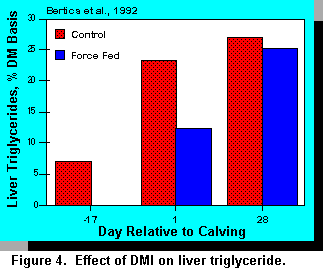 Maximizing feed intake prior to calving appears critical for the prevention of metabolic disorders.
We (2) evaluated the effects of prepartum intake depression on the development of fatty liver.
Eleven cows were fed ad libitum prepartum (control), and another 11 cows were maintained at
the same level of DMI as recorded during days 21 to 17 prepartum by force feeding feed refusals
via rumen cannulae. Feed intake of control cows declined 28% over the final 17 days prepartum.
Liver triglyceride increased 227 and 75% for control and force-fed cows, respectively, between
day 17
prepartum and day 1 postpartum (Figure 4). Cows that were force-fed prepartum produced milk
with a higher fat content (4.22 versus 3.88%), and tended to produce more 3.5% fat-corrected
milk
over the first 28 days postpartum (46.0 versus 41.6 kg/day).
Maximizing feed intake prior to calving appears critical for the prevention of metabolic disorders.
We (2) evaluated the effects of prepartum intake depression on the development of fatty liver.
Eleven cows were fed ad libitum prepartum (control), and another 11 cows were maintained at
the same level of DMI as recorded during days 21 to 17 prepartum by force feeding feed refusals
via rumen cannulae. Feed intake of control cows declined 28% over the final 17 days prepartum.
Liver triglyceride increased 227 and 75% for control and force-fed cows, respectively, between
day 17
prepartum and day 1 postpartum (Figure 4). Cows that were force-fed prepartum produced milk
with a higher fat content (4.22 versus 3.88%), and tended to produce more 3.5% fat-corrected
milk
over the first 28 days postpartum (46.0 versus 41.6 kg/day).
Zamet et al. (40), monitored 89 Holstein cows through the dry period and first 30 days of lactation and categorized cows as being normal or abnormal. Abnormal (n=45) cows were those that had one or more partum or early postpartum disorders diagnosed and treated. Feed intake during the final 27 days prepartum decreased from 1.8% to 1.2% of body weight for normal cows and from 1.8% to .9% of body weight for abnormal cows; DMI was significantly lower for abnormal cows from 3 days prepartum to 1 day postpartum (Figure 5). Differences in feed intake between the two groups increased postpartum and normal cows produced more milk . This data indicates that predisposition to disorders at and immediately following calving may be indicated by reduced DMI prepartum.
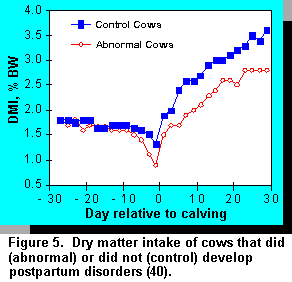
Numerous studies have indicated that overconditioned cows are more likely to have poor appetites postpartum (11, 19). Postpartum feed intake is related to prepartum feed intake (Figure 6), therefore, one might hypothesize that overconditioned cows would also consume less feed prepartum. Emery (10) summarized feed intake during the dry period for 20 multiparous cows. The 10 cows with the highest body condition score (> 3.6; 1 = lean, 5 = obese) consumed DM at approximately 1.5% of body weight and the 10 cows with the lowest body condition score (ó 3.6) consumed DM at 2% of body weight. Overconditioned cows had a higher incidence of health problems within 75 days postpartum. We examined the relationship between body condition score at 17 days prepartum and DMI at 1 day prepartum or 21 day postpartum for 40 cows from 3 completed research trials (2, 31, 32). The correlation coefficient between prepartum body condition score and DMI at 1 d prepartum and 21 days postpartum was .25 and .45.
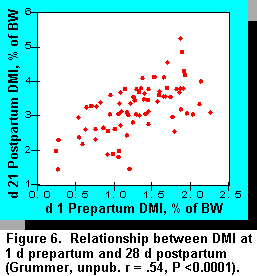
Increasing Dietary Energy Density
One way to offset reduced nutrient intake associated with feed intake depression is to increase nutrient density of the diet. Decreasing forage:concentrate ratio may increase energy intake and help reduce fatty acid mobilization from adipose tissue. Transition cows fed 20% concentrate from 28 to 4 days prepartum had higher DMI (~1.1 kg/day) until day 11 prepartum than did cows fed 5% concentrate during the same period (17). By four days prior to calving until calving, DMI's were not different between the two treatments groups, but cows consuming the diet containing 20% concentrate consumed more energy. Similar results were obtained by Johnson and Otterby (21) for cows fed all alfalfa grass hay or corn silage-alfalfa silage based diets containing 12 or 47% high moisture corn beginning at 30 days prepartum. Increasing high moisture grain in the diet increased DMI from days 28 to 13 prepartum, but not from day 12 prepartum to day 31 postpartum. Coppock et al. (5) fed four diets varying from 75 to 30% forage during the final 28 d prior to calving. Although there were no statistically significant differences among groups, feed intake was highest for cows receiving the two diets with the most grain. However, percentage decrease in feed intake immediately prior to calving was greatest for cows consuming the diet with the most concentrate.
Benefits of having a higher proportion of DM coming from concentrates may go beyond provision of calories. Dirksen et al. (8) demonstrated that reduction of fiber percentage in the prepartum diet increases the development of rumen papillae and increases the capacity for volatile fatty acid absorption from the rumen. Development of the rumen papillae is essential to minimize ruminal volatile fatty acid accumulation, reduction in ruminal pH, and likelihood of acidosis when high grain lactation diets are introduced postpartum. This aspect of lead feeding may be more important than that of adapting the rumen microflora to high starch diets. Because development of the rumen papillae takes four to six weeks (8) concentrate must begin prior to parturition to benefit the cow postpartum.
We attempted to reduce incidence of fatty liver and ketosis by increasing energy density of the diet with supplemental fat. Unlike fat from adipose, dietary fat was believed to be utilized predominantly by tissues other than the liver. Feeding cows supplemental fat 17 days prepartum through early lactation tended to increase liver fat at 1 to 2 days postpartum and at 35 days postpartum (29). A summary of the literature (15) indicated that fat feeding increases plasma fatty acid concentration and has no consistent effect on plasma ketone concentrations.
Increasing Dietary Energy and Protein Density
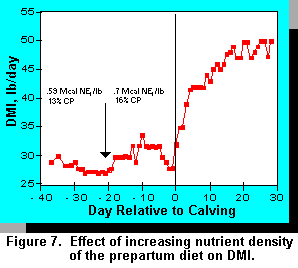 Analysis of data from 31 herds involving
1,374 multiparous cows indicated that higher intakes of
energy and protein during the final three weeks prior to calving may decrease the likelihood of
metabolic disorders after calving (7). Feeding a high energy, high protein diet prepartum reduced
fatty liver score determined by liver biopsies (.5 versus 3.0) compared to feeding a high energy,
low protein diet (Holtenius and Hjort, 1990), but cow numbers were too low (four per treatment)
and ration description too incomplete to draw any firm conclusions. Michigan State workers
observed a 30% increase in DMI when energy density of the diet was increased from 1.30 Mcal
NEl/kg DM to 1.54 Mcal NEl/kg DM and CP was increased from 13 to 16% at about 3 weeks
prior to calving (Figure 7; Emery, 1993). Dry matter intake began to decline at five days prior to
calving, but not below levels observed before the change in dietary energy density. Increasing
energy density from 1.30 to 1.61 Mcal/kg and CP from 12.2 to 16.2% during the final 26 d
prepartum resulted in higher energy intake during the final 14 d prepartum (21 versus 15 Mcal
NEl/d), reduced plasma fatty acids (228 versus 346 uM), and reduced liver triglyceride (9 versus
15 mg/g wet tissue; 34). However, milk yield and body weight was not affected by treatments
(27).
Analysis of data from 31 herds involving
1,374 multiparous cows indicated that higher intakes of
energy and protein during the final three weeks prior to calving may decrease the likelihood of
metabolic disorders after calving (7). Feeding a high energy, high protein diet prepartum reduced
fatty liver score determined by liver biopsies (.5 versus 3.0) compared to feeding a high energy,
low protein diet (Holtenius and Hjort, 1990), but cow numbers were too low (four per treatment)
and ration description too incomplete to draw any firm conclusions. Michigan State workers
observed a 30% increase in DMI when energy density of the diet was increased from 1.30 Mcal
NEl/kg DM to 1.54 Mcal NEl/kg DM and CP was increased from 13 to 16% at about 3 weeks
prior to calving (Figure 7; Emery, 1993). Dry matter intake began to decline at five days prior to
calving, but not below levels observed before the change in dietary energy density. Increasing
energy density from 1.30 to 1.61 Mcal/kg and CP from 12.2 to 16.2% during the final 26 d
prepartum resulted in higher energy intake during the final 14 d prepartum (21 versus 15 Mcal
NEl/d), reduced plasma fatty acids (228 versus 346 uM), and reduced liver triglyceride (9 versus
15 mg/g wet tissue; 34). However, milk yield and body weight was not affected by treatments
(27).
Increasing Dietary Protein Density
Data from the large field trial by Curtis et al. (7) indicated that feeding protein above NRC recommendations during the final three weeks prepartum decreased the risk of retained placenta and uncomplicated (primary) ketosis. Heifers fed 13% CP diets for the final 60 days of their gestation produced more milk during the first lactation than those fed 9% CP diets (20). Feeding rumen-protected lysine and methionine to dairy cows consuming diets containing 12.6% CP and high undegradable intake protein during the final three weeks prepartum reduced the incidence of metabolic disorders at parturition (4/16 versus 5/11; 25). Blood meal was used to increase CP from 12.4 to 15.3% in diets fed to heifers for the final three weeks of gestation (36). Undegradable protein was increased from 27 to 39% of CP. Heifers fed the high undegradable intake protein diet maintained a higher body condition score (3.24 versus 3.03, scale = 1 to 5), produced milk with a higher protein percentage (3.18 versus 2.96%), and had fewer services per pregnancy (1.2 versus 2.1). In a follow up study (35) multiparous cows were fed diets near NRC specifications (approximately 12% CP, undegradable intake protein = 32% of CP) or with elevated CP and undegradable intake protein (approximately 13.5% CP, undegradable intake protein = 42% of CP). Cows fed the high undegradable intake protein diet had a lower incidence of ketosis (0 versus 16.7%) and had fewer days open (72 versus 90). Increasing dietary CP of all corn silage or predominantly corn silage diets from 8 to 15% by addition of soybean meal throughout the entire dry period increased the incidence of postpartum disease from 7.14 (2/27) to 69.2% (18/26; 22). Cows receiving the 15% CP diet suffered a variety of disorders, perhaps most striking was the large number (n = 8) of downer cows, including six that died. All cows on the trial were overconditioned. If liver fat was elevated, the liver's ability to detoxify ammonia resulting from ruminal soybean protein degradation may have been compromised. Chew et al. (3) fed 80% or 100% of NRC recommendations for CP during the entire dry period. Urea was used to increase CP of the corn silage and alfalfa grass hay diets. Cows consuming the 100% treatment consumed more DM (+.1% of BW) prepartum and produced more milk (4,550 versus 5,470 kg) during the first 200 days of lactation. Several recent studies indicated that protein status of the diet prepartum does not influence postpartum performance (6, 27, 39).
Feed Additives
Niacin is a feed additive that has been used to prevent ketosis, presumably by reducing fat mobilization from adipose. A review of the literature (14) indicated that feeding 6 to 12 g niacin/day has inconsistent effects on plasma fatty acids and glucose concentration, but in general, a beneficial influence on plasma ketone concentration. Likelihood of obtaining an antiketogenic response was increased if niacin was fed prepartum and(or) during early lactation. Feeding niacin prepartum through 15 weeks of lactation did not decrease severity of fatty liver at 1 or 35 days postpartum (29).
Propylene glycol (PG) has also been used to treat or prevent ketosis in lactating cows. Propylene glycol is converted to glucose by the liver which increases the concentration of insulin in blood. Insulin acts on adipose tissue to reduce fat mobilization. Studer et al. (32) evaluated the effects of prepartum PG administration on the development of fatty liver in 24 cows. Treated cows were drenched with 32 oz PG once daily starting 10 days prior to expected calving until parturition. Total liver triglyceride measured one day postpartum were 29.5 and 21.4% for control and PG treated cows. Prepartum plasma glucose concentrations were increased and fatty acid concentrations were decreased. Plasma ketones were significantly lower during PG administration and these benefits carried over beyond calving after treatment had been stopped. These results indicate that prepartum PG administration may have a role in the prevention of fatty liver. There were no significant differences between control and PG over the first 21 days postpartum for DMI, milk yield, or milk composition. Because 32 oz of PG is a large dose, we evaluated different doses of PG for ability to reduce plasma fatty acids in feed restricted heifers (16). Ten ounces of PG was almost as effective as 30 oz for increasing plasma glucose and insulin and decreasing plasma fatty acids and ketones.
Drenching PG is labor intensive, therefore, we compared the efficacy of administering PG as an oral drench, mixed with a totally mixed ration, or as a slug dose with grain (.45 kg PG + 2.7 kg grain). Providing PG as an oral drench, or with grain in a single offering separate from forage were similarly effective in increasing plasma insulin and reducing plasma fatty acids (4). Feeding PG as part of a totally mixed ration (TMR) was not as effective, probably because there wasn't sufficient PG consumed at any moment in time to trigger the metabolic changes required to reduce fat mobilization from adipose tissue. Previous research indicates that feed intake is not compromised if PG is limited to less than 5% of ration DM (28).
Although not approved for feeding to lactating dairy cows, ionophore supplementation may act in a similar matter as grain feeding or PG for reducing stress associated with early lactation. Monensin is an ionophore that enhances propionate production in the rumen. Sauer et al. (26) fed monensin at approximately 0, 100, or 200 mg/day from 1 week prepartum until 3 weeks postpartum. Feeding the 200 mg/day from 1 week prepartum until 3 weeks postpartum reduced feed intake 1.2 kg/day and ketones from 7.2 to 3.9 mg/100 mL. Incidence of ketosis was 1 out of 12 for cows receiving the high dose of monensin as compared to 6 out of 12 for cows not receiving monensin. Similar results were obtained by Thomas et al. (33) who fed 0, 150, 300, or 450 mg of monensin/day starting at 2 to 4 weeks prepartum through 84 days postpartum. Feed intake of cows fed monensin was not affected prepartum, but was depressed 0.68 to 2.49 kg/day during the 84 day postpartum period; the difference was significant for cows receiving the lowest dose of monensin. Plasma fatty acids and ketones were reduced at all levels of monensin inclusion. Prepartum blood fatty acids, ketones, and glucose were reduced when cows at 50 days prior to expected calving were dosed with a capsule designed to release 300 mg monensin/day into the rumen for 100 days (30).
Monitor Dietary Cation-Anion Difference
Recent research has indicated that dietary cation-anion difference (DCAD) may be more important than calcium intake for controlling milk fever (24). Diets with a high DCAD are alkaline and tend to cause milk fever. Diets that are negative DCAD are acidic and tent to prevent milk fever. The most common equation for calculating DCAD is: meq[(K + Na) - (Cl + S)]/100 g dietary DM. Decreasing DCAD during the final weeks prior to calving can have beneficial effects on acid-base balance, plasma calcium pools, incidence of milk fever, and postpartum health and reproductive performance. The two most important ways to minimize DCAD (without supplementation of anions) is to avoid forages that are high in potassium (K) and buffers in the prepartum diet. Examples of low K forages include corn silage or alfalfa that has been grown with minimal K supplementation. Feed ingredients, especially forages, vary dramatically in mineral content, consequently, all feed ingredients must be analyzed for K, Na, Cl, and S prior to balancing diets for DCAD. Once the dietary DCAD has been determined, supplementation with anionic salts can be considered. Correct supplementation of anionic salts can be monitored by measuring urinary pH. Anionic salts may be more effective when calcium content of the diet is high (1.5 to 1.8% of dietary DM, 24). This allows the opportunity to feed high quality-low potassium alfalfa during the transition period. In general, anionic salts are not palatable, therefore, careful attention to feed intake must be made. Reductions in feed intake will predispose the cow to other metabolic problems and cause inadequate intake of anionic salts.
Management Recommendations for the Transition Period
Transition period energy intake is a critical factor in determining the susceptibility of the early lactation dairy cow to metabolic disorders. Maximizing feed intake during the transition period must be a priority. Factors regulating transition period feed intake have not been defined. It would seem prudent to offer cows feeds that they like to eat. Provision of high quality forages may encourage feed consumption. Avoid sudden changes in diet ingredients, particularly when changes coincide with inclusion of less palatable feedstuffs such as some supplemental fats and rendered protein sources.
Introducing concentrate during the final two to three weeks prior to calving would benefit the cow by adapting the rumen to high starch diets and providing additional energy during a period when feed intake normally declines. Recommended diet specifications for the transition cow consuming 10.0 to 10.4 kg DM/d are 14 to 15% CP, 33 to 38% undegradable intake protein (% of CP), 1.50 to 1.59 Mcal NEl/kg, 25 to 30% minimum ADF, 35 to 40% minimum NDF, and 30 to 35% nonfiber carbohydrate (28). Feeding transition cows forage and concentrate as a TMR should be encouraged to ensure forage to grain ratio remains constant.
If a TMR cannot be fed, cows should be individually fed. If cows are not individually fed, but have access to multiple feed ingredients, each cow will formulate their own unique diet based on preference of feed ingredients and/or social standing in their group. If forage is fed separate from grain and cows select against forage during feed intake depression, grain intake relative to forage may become excessive. This may result in acidosis, off-feed problems, and displaced abomasums due to inadequate rumen fill. Preparation of a unique TMR for transition cows may not be an option for some producers. Blending a high group TMR with dry cow forage may produce an acceptable diet, however, calcium and buffer supplementation of the high group ration may cause the transition diet to be high in cations. Use of anionic salts to control milk fever may be warranted. Diluting a high group TMR by feeding dry cow forage separately is undesirable because cows will have a choice in what they eat. All forage diets are not adequate because they will not meet the diet specifications cited above.
Avoid unneeded stress near the time of calving. Stress may cause the transition cow to eat less and may trigger hormonal changes that promote fat mobilization from adipose tissue. Gerloff et al. (12) noted higher plasma fatty acids in prepartum cows that were housed in a competitive group situation versus those housed in individual box stalls. Minimize sudden environmental changes. For example, moving a close-up dry cow or heifer from cold loose housing to a warm stanchion barn where different feeds are offered may predispose a cow to go off- feed.
If milk fever is a problem and restriction of calcium intake has not eliminated the problem, determine DCAD. Although optimum DCAD has not been established, current recommendations are to achieve -10 to -15 meq/100 g dietary DM (1). Avoid forages with high levels of cations (e.g. K). Anionic salts are unpalatable and excessive amounts would need to be supplemented to achieve the desired DCAD if cation content of the basal diet is high. Feeding strategies have been described by Beede (1). Supplement magnesium sulfate, calcium sulfate, and ammonium sulfate until dietary sulfur reaches .4 to .5% of DM. If further supplementation is required, add calcium chloride or ammonium chloride. Magnesium should not exceed .4% of DM and calcium should be increased to 1.5 to 1.8% of DM. Acid-base balance of the herd can be made by monitoring urinary pH. Target pH between 5.5 and 6.5.
Additional Readings
Applied Dairy Science Course - University of Alberta:
Management of Dry Cows
Alberta Dairy Management Fact Sheet:
Dietary Cation-Anion Balance
References
1. Beede, D. 1995. Macromineral Element Nutrition for the Transition Cow: Practical Implications and Strategies. In: Proc. Tri-State Dairy Nutr. Conf., Ohio State University, Michigan State University, and Purdue University, Fort Wayne, IN. pp. 175.
2. Bertics, S.J., R.R. Grummer, C.Cadorniga-Valino and E.E. Stoddard. 1992. J. Dairy Sci. 75:1914.
3. Chew, B.P., F.R. Murdock, R.E. Riley and J.K. Hillers. 1984. J. Dairy Sci. 67:270.
4. Christensen, J.O., F.E. Rasmussen and R.R. Grummer. 1995. J. Dairy Sci. 78(Suppl. 1):240.
5. Coppock, C.E., C.H. Noller, S.A. Wolfe, C.J. Callahan and J.S. Baker. 1972. J. Dairy Sci. 55:783.
6. Crawley, D.D. and L.H. Kilmer. 1995. J. Dairy Sci. 78(Suppl. 1):266
7. Curtis, C.R., H.N. Erb, C.J. Sniffen, R.D. Smith and D.S. Kronfeld. 1985. J. Dairy Sci. 68:2347.
8. Dirksen, G.U., H.G. Liebich and E. Mayer. 1985. Bovine Pract. 20:116.
9. Dyke, P.B., R.S. Emery, J.L. Liesman, H.F. Bucholtz and M.J. VandeHaar. 1995. J. Dairy Sci. 78(Suppl. 1):264.
10. Emery, R.S. 1993. Energy needs of dry cows. In: Proc. Tri-State Dairy Nutr. Conf. Ohio State Univ., Michigan State Univ., and Purdue Univ., Ft. Wayne, IN. pp 35.
11. Garnsworthy, P.C. and G.P. Jones. 1987. Anim. Prod. 44:347.
12. Gerloff, B.J., T.H. Herdt, W.W. Wells. J.S. Liesman, R.S. Emery. 1986. J. Anim. Sci. 62:1682.
13. Goff, J.P. 1992. Cation-Anion Difference of Diets and its Influence on Milk Fever and Subsequent Lactation: The Good and the Bad News. Page 148 in Proc. Cornell. Nutr. Conf., Cornell Univ., Ithaca, NY.
14. Grummer, R.R. 1993. J. Dairy Sci. 76:3882.
15. Grummer, R.R. and D.J. Carroll. 1991. J. Animal Sci. 69:3838.
16. Grummer, R.R., J.C. Winkler, S.J. Bertics and V.A. Studer. 1994. J. Dairy Sci. 77:3618.
17. Hernandez-Urdaneta, A., C.E. Coppock, R.E. McDowell, D. Gianola and N.E. Smith. 1976. J. Dairy Sci. 59:695.
18. Holtenius, P., G. Olsson and C. Bjorkman. 1993. J. Vet. Med. A 40:118.
19. Holter, J.B., M.J. Slotnick, H.H. Hayes, C.K. Bozak, W.E. Urban, Jr., and M.L. McGilliard. 1990. J. Dairy Sci. 73:3502.
20. Hook, T.E., K.G. Odde, A.A. Aguilar and J.D. Olson. 1989. J. Anim. Sci. 67(Suppl. 1):539 (Abstr.).
21. Johnson, D.G. and D.E. Otterby. 1981. J. Dairy Sci. 64:290.
22. Julien, W.E., H.R. Conrad and D.R. Redman. 1977. J. Dairy Sci. 60:210.
23. National Research Council. 1989. Nutrient Requirements of Dairy Cattle. 6th Rev. Ed. Natl. Acad. Sci., Washington, DC.
24. Oetzel, G. 1994. Minimizing Postpartum Metabolic Problems. In: Proc. Tri-State Dairy Nutr. Conf., Ohio State University, Michigan State University, and Purdue University, Fort Wayne, IN. pp. 1.
25. Rode, L.M., T. Fujieda, H. Sato, H. Suzuki, W.E. Julien and C.J. Sniffen. 1994. J. Dairy Sci. 77(Suppl. 1):243.
26. Sauer, F.D., J.K.G. Kramer and W.J. Cantwell. 1989. J. Dairy Sci. 72:436.
27. Sharma, B.K., G. Yousif and M.J. Vandehaar. 1995. J. Dairy Sci. 78(Suppl. 1):265.
28. Shaver, R. 1993. TMR strategies for transition feeding of dairy cows. In: 54th Minnesota. Nutr. Conf. & Natl. Renderers Tech. Symp. p 163. Bloomington, MN.
29. Skaar, T.C., R.R. Grummer, M.R. Dentine and R.H. Stauffacher. 1989. J. Dairy Sci. 72:2028.
30. Stephenson, K.A., I.J. Lean, M.L. Hyde and L.B. Lowe. 1994. J. Anim. Sci. 72:384 (Abstr.).
31. Studer, V.A. 1993. Use of prepartum propylene glycol or insulin administration for the prevention of periparturient fatty liver. MS Thesis, University of Wisconsin, Madison.
32. Studer, V.A., R.R. Grummer and S.J. Bertics. 1993. J. Dairy Sci. 76:2931.
33. Thomas, E.E., S.E. Poe, R.K. McGuffey, D.H. Mowrey and R.D. Allrich. 1993. J. Dairy Sci. 76(Suppl. 1):280.
34. Vandehaar, M.J., B.K. Sharma, G. Yousif, T.H. Herdt, R.S. Emery, M.S. Allen, and J.S. Liesman. 1995. J. Dairy Sci. 78(Suppl. 1):264.
35. Van Saun, R.J. 1993. Effects of undegradable protein fed prepartum on subsequent lactation, reproduction, and health in Holstein dairy cattle. Ph.D. Thesis. Cornell University, Ithaca, NY.
36. Van Saun, R.J., S.C. Idleman and C.J. Sniffen. 1993. J. Dairy Sci. 76:236.
37. Vazquez-Anon, M., S. Bertics, M. Luck and R.R. Grummer. 1994. J. Dairy Sci. 77:1521.
38. Veenhuizen, J.J., J.K. Drackley, M.J. Richard, T.P. Sanderson, L.D. Miller and J.W. Young. 1991. J. Dairy Sci. 74:4238.
39. Wu, Z., R. Fisher and C.E. Polan. 1995. J. Dairy Sci. 78(Suppl. 1):266.
40. Zamet, C.N., V.F. Colenbrander, C.J. Callahan, B.P. Chew, R.E. Erb and N.J. Moeller. 1979. Theriogenology 11:229.